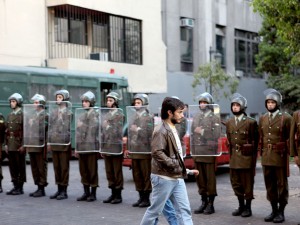No centers on campaign slogan, not Chilean history
Though the recent regime changes that took place during the Arab Spring proved to be a victory for social media and democracy, its aftermath, plagued by uncertainty and ambiguous goals, has nearly undermined the entire movement. It seemingly shows the inherent problems of having a revolution shift toward a form of retribution rather than the pursuit of a brighter future.

Positive · René Saavedra (Gael García Bernal) leads a revolutionary positive political campaign to unseat Chilean dictator Augusto Pinochet in No. Saavedra’s advertisements mobilized voters to elect a parliamentary government. – Courtesy of Sony Pictures Classics
Oscar nominee for Best Foreign Language Film shows that by using marketing and advertising techniques to promote the prospect of happiness, rather than vengeance, as a weapon against the previous regime, genuine political and social change can be achieved.
The film, set in 1988, centers on the Chilean public’s opportunity to decide whether or not General Augusto Pinochet should be allowed to stay in power or leave office.
After a growing amount of international pressure forces the military dictator to allow the Chilean public to decide whether or not he should stay in office, the government, which still controls the airwaves, only allows the opposition, known simply as the NO coalition, to have 15 minutes of campaign marketing on public airwaves during the 27 nights leading up to the election.
The NO coalition selects a young TV marketing expert, René Saavedra (Gael García Bernal) to spearhead the people’s marketing campaign to oust Pinochet. Instead of focusing on the heinous acts committed by Pinochet, be it the CIA-backed military coup d’état, the thousands of imprisoned political prisoners or even the desaparecidos — the thousands of people who “disappeared” through the years — Saavedra does something novel, focusing the campaign on ideas of happiness and optimism.
Despite skepticism and criticism that the campaign will become something similar to a Coke commercial, Saavedra stands by his decision, reasoning that if the campaign resorts to criticism and fear, they’ll lose the vote.
The NO campaign was revolutionary for its time, transforming political campaigning into a hybrid of commercialism and feathery optimism. Though some might argue that the campaign contributed to the dumbing down of politics, it was nevertheless a remarkably effective campaing, with 55.99 percent of Chileans voting ‘no’ to an extended Pinochet reign. Perhaps even more remarkable was that the campaign also encouraged an incredible 97.52 percent of the eligible voting population to turn out to cast their ballot.
Chilean director Pablo Larraín approaches the material, based on the unpublished play El Plebiscito by Antonio Skármeta, very much like the main character would. Though it would certainly be effective to remind the audience of the tyranny of the Pinochet regime, by steering the film with optimism and the simplicity of saying “no” to the past and “yes” to the future, the film proves to be an effective reminder of the power of optimism in the face of tyranny.
There has been some criticism that Larraín in many ways simplified a political campaign to a TV commercial. However, Larraín seems fully aware that the silliness and possible detriment of reducing a campaign to this and, if one pays attention, it is clear that the film itself does carry some notes of irony. The film makes a point to show that Saavedra, who is solely committed to the idealism of marketing, is slightly unhappy himself and feels uncertain of his own future.
Bernal himself also strikes the right balance between cockiness and pathos, and the little moments of weakness and exposure his character goes through stand out against the image of the hotshot ad executive he generally presents himself as.
For the look of the film, Larraín took the novel approach of using low definition, 3/4’ Sony U-matic magnetic tape, which was widely used by television news in Chile during that time. By using the same analog cameras, Larraín creates a level of seamlessness comparable to the look of Forrest Gump, with the film fading in and out of the actual commercials and political ads used during the campaign.
In some areas, the line between the film and the actual footage is flawless; nowhere is this more evident than in scenes depicting actual police crackdowns and pro-democratic assemblies. At a certain point, you’re no longer able to tell the difference between the two, which gives the film an impressive sense of verisimilitude.
Much like the campaign at the core of the feature, the film No is efficient, memorable and doesn’t get bogged down in the details. Though it might not dig too deep into the state of the culture or the mentality of the Chilean populace, the film makes a valid point that sometimes the simplest approach is the most effective for providing a positive experience for those involved, both politically and emotionally.
